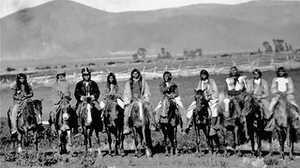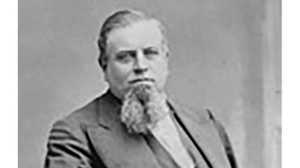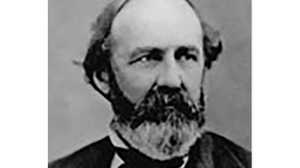Native Americans and the Transcontinental Railroad

As white explorers and settlers entered Western territory, they disrupted a centuries-old culture — that of the Plains Indians. The arrival of the railroad and, with it, more permanent and numerous white settlement, spelled growing conflict between whites and natives. The troubles would erupt into an all-out war.
Massacre at Sand Creek
In autumn 1864, while the Civil War raged half a continent away, a group of Cheyenne Indians made winter quarters on Sand Creek in Colorado Territory, having been invited there by the U.S. Army. Forty miles away, at Fort Lyon, a regiment of cavalry mustered under Colonel John Chivington. Chafing for action, Chivington led his soldiers under cover of night to sleeping Sand Creek. At daybreak on November 29th, Chivington unleashed his men with the infamous order, "Kill and scalp all, big and little; nits make lice." The soldiers swept down upon the camp, surrounding unarmed natives and chasing away their ponies to prevent escape. Chief Black Kettle waved the white flag to no avail. Indiscriminate slaughter followed. Over 150 Cheyenne were murdered, most women and children. The rampaging soldiers mutilated their corpses, some removing genitals as prizes.
Retribution at Julesburg
Retribution fell 39 days later upon the frontier town of Julesburg, Colorado. An assembly of 1,000 Sioux, Arapaho, and Northern Cheyenne — survivors of Sand Creek among them — overran the town, killing civilians and soldiers and distributing their body parts across the countryside. They continued through Platte Valley, destroying stage stations and telepgraph wires, effectively halting transcontinental communication. Later, the party returned to Julesburg and burned it to the ground.
Armed Response
General Grenville Dodge led the campaign against the northern Plains Indians following Julesburg, effectively dispersing war parties northward to the Powder River Valley. Dodge sent General Patrick Edward Connor after them with troops and scouts from one tribe friendly to whites, the Pawnees. Connor and his men missed the raiders but attacked a peaceful settlement of unsuspecting Arapaho on the Tongue River, killing almost 200.
The "Menace"
As the Union Pacific cut its way westward across the Platte Valley in 1865, its workers grew fearful of "the Indian menace." Certainly, the Northern Cheyenne, Sioux, and Arapaho maintained a presence on what had once been their prime hunting land. However, decades of mass immigration by settlers along the overland trails had already destroyed large swaths of the countryside for buffalo herds, forcing the tribes to disperse in search of food. Tribal leaders, wary of further conflicts with whites, usually ordered their warriors to stay away from the railroad, although young men could not always be controlled. Periodic sightings of Native Americans, skirmishes, and livestock raids persuaded chief engineer Dodge that the railroad needed serious protecting. He repeatedly requested troops of William Tecumseh Sherman. The latter declined, convinced that natives posed no real threat to the project.
Slaughter on the Bozeman Trail
An event in 1866 changed Sherman's attitude and put fear into the hearts of railroad workers, although it occurred away from their line. Plains Indians had watched as the Platte Valley turned into white America's highway. Now they were incensed by army fortification of the Bozeman trail through the Powder River Valley, their most sacred and fertile hunting ground. On December 21, decoys attacked a wood train outside Fort Philip Kearny. A garrison led by arrogant Captain William J. Fetterman, who had once boasted he could lick the entire Sioux tribe with just 80 men, rushed from the fort to support the wood-gathering party. As he left, a superior officer told Fetterman three times not to engage the Indians. He ignored orders. Indian decoys led their pursuers into a waiting mass of Cheyenne, Miniconjous, and Red Cloud's Oglala Sioux. Not a single soldier survived. "We must act with vindictive earnestness against the Sioux," Sherman seethed, "even to their extermination, men, women, children." For the immediate future, however, the army did nothing. Westward progress would suffice to force Native Americans from the Plains.
Incidents Along the Railroad
The railroad certainly received its share of harassment. Livestock was continuously rustled by tribal raiders, who also boldly shot up work crews and terrorized isolated station towns. Particularly vulnerable were route surveyors, who struck out on their own ahead of the work crews -- and sometimes paid for it with their lives. Twice, Native Americans sabotaged the iron rails themselves. In August 1867 a Cheyenne raiding party decided they would attempt to derail a train. They tied a stick across the rails and succeeded in overturning a handcar, killing its crew of repairmen, with the exception of a man named William Thompson. He was shot and scalped, but lived to tell about it as he travelled back to Omaha with his scalp in a pail of water by his side. In 1868 a group of Sioux created a more intense blockade, upturning both rails and piling wooden ties in between them, then tying the whole thing together with telegraph wire. The resulting wreck killed two crewmen, one of whom was crushed beneath the train's boiler.
One Welcoming Tribe
Of all the Plains tribes, Pawnee Indians had the greatest presence on the line. Friendly to the American government and bitter enemies of the Sioux, the tribe welcomed the Union Pacific to their lands. The railroad offered Pawnee people free passage on its work trains, which the natives gladly accepted. In exchange, they staged mock raids and battles for visiting dignitaries at UP executive Thomas c. Durant's lavish 100th Meridian Excursion party. Under army Major Frank North, a uniformed battalion of 800 Pawnee men patrolled the railroad to protect crews and livestock from Sioux raiders. Their presence as a deterrent was quite effective. "I have never seen more obedient or better behaved troops," gushed one of North's superiors. "They have done most excellent service."
A Lost World
In 1876 the United States celebrated its might, gathered in part from the completion of the railroad, at the Centennial Exposition in Philadelphia. There on exhibit were the "very aristocracy of the Indian nation." The tribes who had roamed and hunted in the woods of the Northeast and the plains of the West found themselves a curiosity for the fair's visitors. The struggle was over, and Native American tribes had lost it, leaving the world of the West forever changed.







